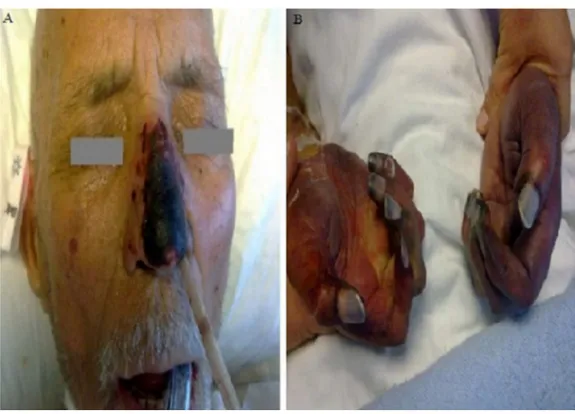Letter
to
the
Editor
Digital
ischemic
necrosis
with
cryoglobulinemia
associated
with
hepatitis
B
infection
A77-year-oldmalepatientpresentedwithaoneweekhistory
of general worsening condition, with mental status and
respiratory insufficiency. He was thereforeadmitted tothe
IntensiveCareUnit.Hispastmedicalhistorywas
unremark-ableexcept for hypertension.He hadcyanosis of the nose,
handsandfeetwithpurpletoblackdiscoloration(Fig.1).Initial
laboratorystudyresultswerenotableforleukocytes:24,000/
mm3,neutrophils:85%,hemoglobin:8.6g/dL, thrombocytes:
120,000/mm3,erythrocytesedimentationrate(ESR):110mm/
h,C-reactiveprotein(CRP):64mg/L,aspartate
aminotransfer-ase:83U/L,alanineaminotransferase:125U/L,BUN:110mg/
dL,creatinine:3.4mg/dL.Inthedifferentialdiagnosis,sepsis
withmultiorganfailureandcoronaryarterydiseasewithacute
heartfailurewereconsidered.
Myeloproliferative diseases, autoimmune diseases, and
HCV infection were ruled out by awide clinico-serological
work-up.ANA,P-ANCA,C-ANCA,anti-dsDNA,anti-Sm,
anti-RNP, and rheumatoid factor were found to be negative.
journalof orthopaedics13(2016)448–449
Fig.1–Clinicalappearanceofacrocyanosisonnoseandhandswithpurpletoblackdiscoloration.
Keywords:
Digitalischemicnecrosis
Cryoglobulinemia
HepatitisB
Available
online
at
www.sciencedirect.com
ScienceDirect
HepatitisBsurfaceantigen(HBsAg)waspositive,andHepatitis
B‘‘e’’antigen(HBeAg)wasnegative.ThehepatitisBviralload
waspositiveat3300IU/ml.
Cryoglobulinswerepositiveinserum,whichwerethought
tobethecauseoftheclinicalpictureandacuterenalfailure.
Thecryoprecipitatewascharacterizedby
immunoelectropho-resis, whichshowedthat theproteins containedpolyclonal
immunoglobulinIgG,whiletherewasnomonoclonalprotein.
Thefinaldiagnosiswasmadeasmixedtypecryoglobulinemia
withacrocyanosisandacutedigitalischemicnecrosis
associ-ated with hepatitis-B. Despite aggressive, supportive
anti-microbials and lamivudine treatment, the patient's clinical
course deteriorated, and the patient died of a myocardial
infarctiononhospitaldaythree.
Theacuteonsetofacrocyanosisalongwithabnormalvital
signsisaredflagsymptomofanunderlying,potentially
life-threatening disease such as an embolic phenomenon or
vasculitis.
Mixed cryoglobulinemia (MC), type II and type III, are
definedas the presence of circulating cryoprecipitable
im-munecomplexesintheserum.1,2Rarelyencounteredinthe
clinicalsetting,itspresentationischaracterizedbyaclassical
clinicaltriadofpurpura,weakness,andarthralgias.1Itstrue
prevalence remains unknown, however MC is noted for
variableorganinvolvement,includingskinlesions(orthostatic
purpura, ulcers), chronic hepatitis, membranoproliferative,
glomerulonephritis,peripheralneuropathy,diffusevasculitis,
Raynaud'sphenomenon,andlessfrequently,interstitiallung
involvementand endocrine disorders.1–3 High cryocrit level
maycauseischemiccardiacorcerebrovasculardisease.4
AlthoughchronicHCVinfectionisknowntobethemost
significantinfectionrelatedtotypeIImixedcryoglobulinemia,
a few reported cases have shown the significance of HBV
infectioninthiscondition.1,2Inpatientswithcomorbidities
such as renal disease, liver failure, lymphoproliferative
disease,andmalignancies,overallprognosisisusuallyworse.
Thepresentcaseunderlinestheimportanceofrecognizing
cryoglobulinemia. In patients with hepatitis B infection,
cryoglobulinemiaisararebutcrucialextrahepatic
manifesta-tionthatmayberelatedtohighmorbidityandmortality.
Conflicts
of
interest
Theauthorshavenonetodeclare.
r
e
f
e
r
e
n
c
e
s
1. FerriC.Mixedcryoglobulinemia.OrphanetJRareDis.2008;3:25.
2. YamazakiT,AkimotoT,OkudaK,etal.Purpurawith ulcerativeskinlesionsandmixedcryoglobulinemiaina quiescenthepatitisBviruscarrier.InternMed.2014;53: 115–119.
3. GrigorescuI,DumitrascuDL.Spontaneousand antiviral-inducedcutaneouslesionsinchronichepatitisBvirus infection.WorldJGastroenterol.2014;20:15860–15866.
4. BrownPJ,ZirwasMJ,English3rdJC.Thepurpledigit:an algorithmicapproachtodiagnosis.AmJClinDermatol. 2010;11:103–116.
FerhatArslan
DepartmentofInfectiousDiseasesandClinicalMicrobiology,
IstanbulMedipolUniversityHospital,Istanbul,Turkey
ErgenekonKaragöz*
DepartmentofInfectiousDiseasesandClinicalMicrobiology,
GATAHaydarpasaTrainingHospital,Istanbul,Turkey
AliMert
DepartmentofInfectiousDiseasesandClinicalMicrobiology,
IstanbulMedipolUniversityHospital,Istanbul,Turkey
*Correspondingauthor.
E-mailaddress:ergenekonkaragoz@hotmail.com(E.Karagöz)
Received20April2015
Availableonline20October2015
http://dx.doi.org/10.1016/j.jor.2015.09.008
0972-978X/
#2015Prof.PKSurendranMemorialEducationFoundation.
PublishedbyElsevier,adivisionofReedElsevierIndia,Pvt.Ltd.
Allrightsreserved.
